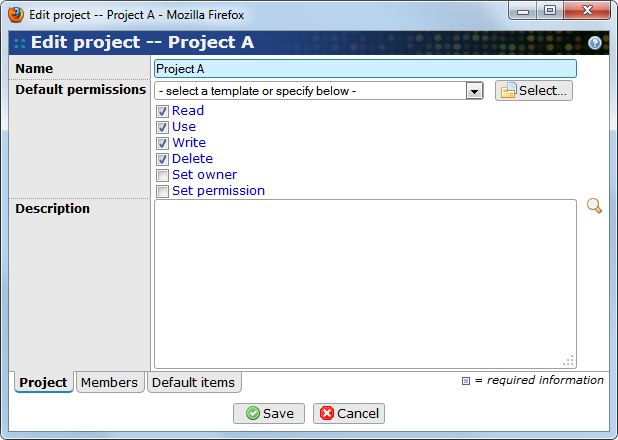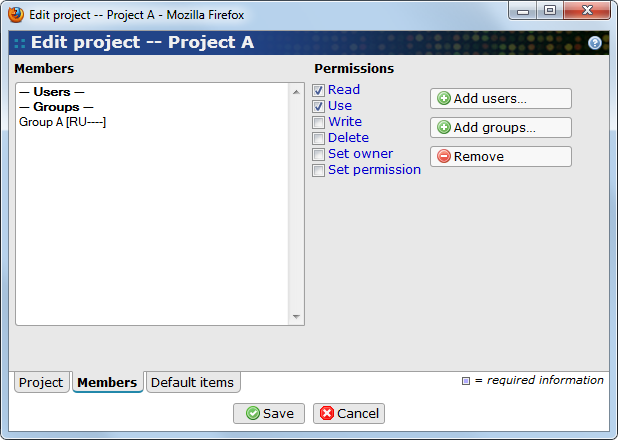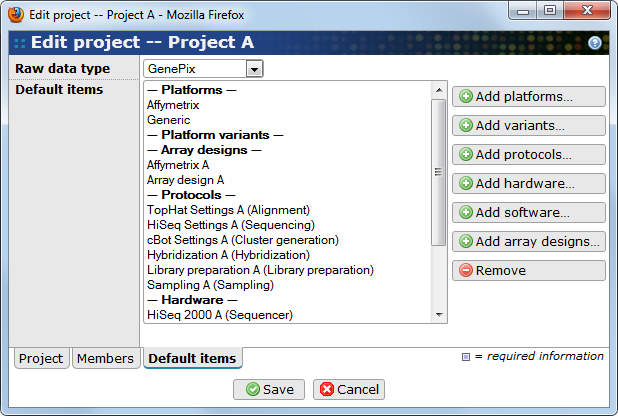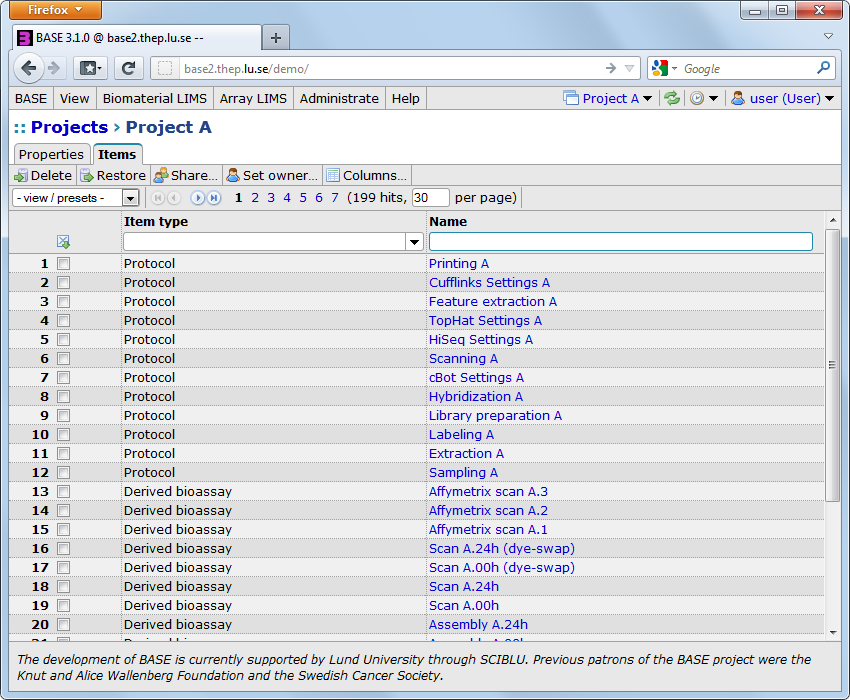Projects are an important part of BASE and the permission system for several reasons:
-
They do not require an administrator to setup and use. All regular users may create a project, add items to it and share it with other users. You are in complete control of who gets access to the project, the items it contains and which permission levels to use.
-
All items in a project are treated as one collection. If a new member joins the team, just give the new person access to the project and that person will be able to access all items in the project.
-
When you create new items, they are automatically shared using the settings from the active project. There is almost no need to share items manually. All you have to remember is to set an active project, and this is easy accessible from the menu bar.
-
Filter out items that you do not want to see. When you have set an active project you may choose to only see items that are part of that project and no other items (Section 5.4.5, “Presets”).
-
It's easy to share multiple items between projects. Items may be part of more than one project. If you create a new project that builds on a previous one you can easily share some or all of the existing items to the new project from one central place, the Items tab on the project's single-item view.
-
It is possible to assign default protocols, software, hardware and other items to a project. This makes it easier when creating new items since BASE will automatically suggest, for example the extraction protocol used when creating a new extract. The default items are also used by the item overview validation functionality, which makes it possible to spot mistakes. See Section 5.6, “Item overview”.
You can list and manage all of your projects by going to . Use the button to create a new projects.
This tab allows users to enter essential information about a project.
- Name
-
The name of the project. We recommend that project names are unique, since at some times it may need to be referenced by name.
- Default permissions
-
This setting specify the permissions to give to new items that are created while this project is the active project. The recommended setting is delete permission. Optionally, a permission template may be selected, in which case the permissions are copied from the template to the new item. See Section 6.3, “Permission templates” for more information.
- Description
-
A optional description of the project.
The active project concept is central to the sharing system. You should always, with few exceptions, have a project active when you work with BASE. The most important reason is that new items will automatically be shared using the settings in the active project. This considerably reduces the time needed for managing access permissions. Without an active project you would have to manually set the permission on all items you create. If you have hundreds of items this is a time-consuming and boring task best to be avoided.
If you work with multiple projects you will probably find the filtering function that hides items that are not part of the active project to be useful. As a matter of fact, if you try to access an item that is part of another (not active) project you will get an error message saying that you do not have permission to access the item (unless you are the owner).
Since it's important to always have an active project there are several ways to make a project the active one.
-
The easiest way and the one you will probably use most of the time is to use the menu bar shortcut. Look in the menu for the project icon
 .
Next to it, the name of the active project is displayed. If you see
.
Next to it, the name of the active project is displayed. If you see
 no active project
here, it means that you have not selected a project to work in. Click on the icon or
project name to open a drop-down menu and select a project to set as
the active project. If another project is already active it will
automatically be inactivated.
no active project
here, it means that you have not selected a project to work in. Click on the icon or
project name to open a drop-down menu and select a project to set as
the active project. If another project is already active it will
automatically be inactivated.
The most recently used projects are listed first, then the list is filled with the rest of your projects up to a maximum of 15. If you have more projects an option to display the remaining projects is activated.
![[Tip]](../../gfx/admonitions/tip.png)
Tip The sort order of the non-recent projects is the same as the sort order on the projects list page. If you, for example, want to sort the newest project first, select to sort by the Registered column in descending order on the list page. The menu will automatically use the same order.
-
Use the menu and select the project from the submenu that opens up.
-
Go to the homepage using the menu and select a project from the list displayed there.
![[Note]](../../gfx/admonitions/note.png) |
Note |
|---|---|
| Only one project can be active at a time. |
![[Caution]](../../gfx/admonitions/caution.png) |
Caution |
|---|---|
| If you change the active project while viewing an item that you no longer has access to in the context of the new project an error message about missing permission will be displayed. Unfortunately, this is all that is displayed and it may be difficult to navigate to a working page again. In the worst case, you may have to go to the login page and login again. |
When a project is active all new items you create are automatically shared using the settings from the active project. If the active project has a permission template the permissions from the template are copied to the new item. If the project doesn't have a permission template, the new item is shared to the active project with the configured default level. By default, projects doesn't have a permission template and the default permissions are set to read, use, write and delete. It is possible to change the default permission level by modifying the settings for the project. Simply open the edit-view page for the project and select the permissions you want and save. From now on, all new items will be shared with the specified permissions. Items that are already in the project are not affected by the change.
First, you will need to open the Edit project dialog. Here is how to do that:
-
Navigate to the single-item view of your project from the list.
-
Click on the button to open the Edit project dialog.
-
Switch to the Members tab. From this page you can add and remove users and change the access levels of existing ones.
- Members
-
The members list contains users and groups that are already members of the project. The list shows the name and the permission level. The permission level uses a one-letter code as follows:
- R = Read
- U = Use
- W = Write
- D = Delete
- O = Set owner
- P = Set permission
- Permissions
-
When you select an user or group in the list the current permission will be checked. To change the permissions just check the permissions you want to grant or uncheck the permissions you want to revoke. You may select more than one user and/or group and change the permissions for all of them at once.
![[Note]](../../gfx/admonitions/note.png)
Note In most cases, you should give the project members use permission. This will allow a user to use all items in the project as well as add new items to it. If you give them write or delete permission they will be able to modify or delete all items including those that they do not own.
This rule is valid for all items that are shared to the project with the default delete permission. Items that are shared with a lower permission, for example, use, can be accessed with at most that permission.
-
Opens a popup window that allows you to add users to the project. In the popup window, mark one or more users and click on the button. The popup window will only list users that you have permission to read. Unless you are an administrator, this usually means that you can only see users that:
-
you share group memberships with (the Everyone group and groups with hidden members doesn't count)
-
are members of the currently active project, if any.
Users that already have access to the project are not included in the list. If you don't see a user that you want to add to the project, you'll need to talk to an administrator for setting up the proper group membership.
-
-
Opens a popup window that allows you to add groups to the project. In the popup window, mark one or more groups and click on the button. Unless you are an administrator, the popup window will only list groups that you are a member of. It will not list groups that are already part of the project.
-
Click on this button to remove the selected users and/or groups from the project.
Use the button to save your changes or the button to close the popup without saving.
A number of default item can be assigned to a project. It is possible to select one raw data type and any number of platforms, variants, protocols, hardware, software and array designs. The default items are used by BASE to suggest default values. The subtype (see Chapter 12, Item subtypes and categories) of each item is used as a filter so that, for example, an extraction protocol is suggested when creating an extract, and a hybridization protocol when creating a hybridization. Use the various buttons to add items to the project and the button to remove them.
![[Note]](../../gfx/admonitions/note.png) |
Note |
|---|---|
|
Make sure that the items that are selected as default items also are shared to the project with at least use permission. Otherwise the default items will not show up for other members of the project, which may result in registering incorrect data. |
If you go to the single-item view for a project you will find that there is an extra tab, Items, on that page.
Clicking on that tab will display a page that is similar
to a list view. However there are some differences:
-
The list is not limited to one type of item. It can display all items that are part of the project.
-
It support only a limited set of columns (id, name, description, owner and a few more) since these are the only properties that are common among all items.
-
The list cannot be sorted. This is due to a limitation in the query system used to generate the list.
![[Note]](../../gfx/admonitions/note.png) |
Note |
|---|---|
| The list only works for the active project. For all other projects it will only display items that are owned by the logged in user. |
There are also several similarities:
-
It supports all of the regular multi-item operations such as delete, restore, share and change owner.
-
Clicking on the name of the item will take you to the single-item view of that item. Holding down CTRL, ALT or SHIFT while clicking, will open the edit popup.
![[Tip]](../../gfx/admonitions/tip.png) |
Tip |
|---|---|
|
This list is very useful when you are creating a new project, in which you want to reuse items from an old project.
If you have more than one old project, repeat the above procedure. |



